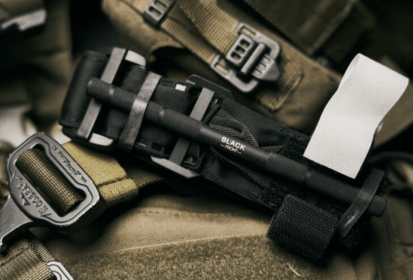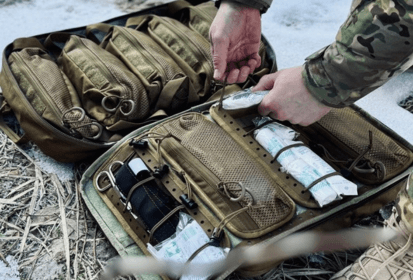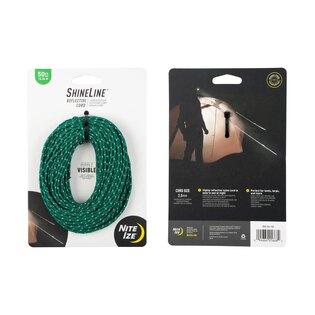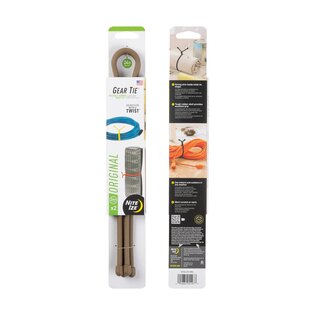12+ Essential Knots: A Guide for Everyday and Emergency Use
The right knot, chosen and tied correctly, can be far more useful than it first appears—it can help you build a shelter, secure gear, and even save the day in an emergency. This article provides an overview of essential knots, grouped by their purpose, along with their advantages, limitations, and practical tips for tying them. These knots are valuable not only in the outdoors, but also for everyday tasks at home, at work, or while traveling.
In the sections ahead, we’ll look at which common knots are best suited for various—and sometimes less-than-common—situations. But before we start tying, let’s take a moment to talk about the ropes we’ll be working with.
Types of Ropes and Paracords
When tying knots, the most commonly used options are static rope, dynamic rope, and paracord (parachute cord). Each has distinct properties and ideal applications.
?? Static rope has minimal stretch, making it well-suited for rappelling, high-altitude work, or rescue operations.
?? Dynamic rope, by contrast, stretches under load, absorbing impact forces—an essential quality for sport climbing.
Ropes intended for securing people must be explicitly certified for that purpose. Without certification, a rope cannot be safely used in any life-safety application.
?? Paracord is a lightweight nylon cord with an inner core. It’s highly versatile—useful for gear repairs, shelter building, securing equipment, or crafting small accessories. However, it is not designed for supporting human weight. The only exception is an extreme emergency when no other option is available, and even then, it should be used strictly at one’s own risk.
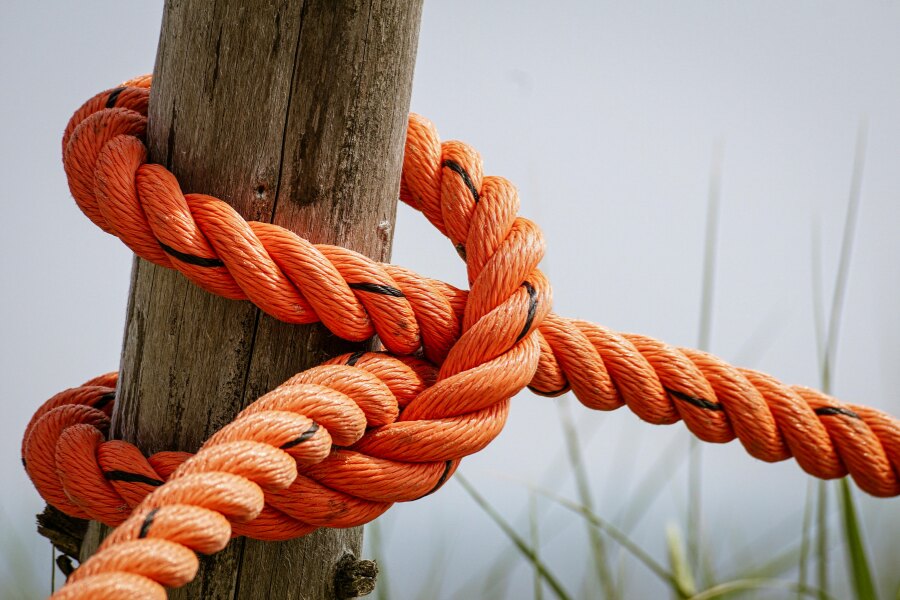
Knot on a strong rope—an example of securely fastening a rope to a post, commonly used in maritime, outdoor, and construction settings. This knot is primarily intended to hold and maintain tension along the rope’s direction.
Basic Knots by Purpose
Knots can be categorized according to their primary function. In this overview, they are divided into four main groups:
- Safety and sport use
- Joining ropes and materials
- Utility and everyday use
- Professional, technical, and specialized techniques
?? Knots for Safety and Sport Use
?? Prusik Knot
The Prusik knot is a friction hitch used for climbing safety, rescue operations, or as part of pulley systems. It is named after Austrian mountaineer Karl Prusik.
?? Prusik Knot
Purpose:
Belaying in climbing, rescue operations, and pulley systems
? Advantages:
• Slides under low load
• Self-locks under tension
• Quick and easy to tie
?? Disadvantages:
• High friction – risk of rope overheating
• Less reliable on wet or slippery ropes
• Not suitable for dynamic loads
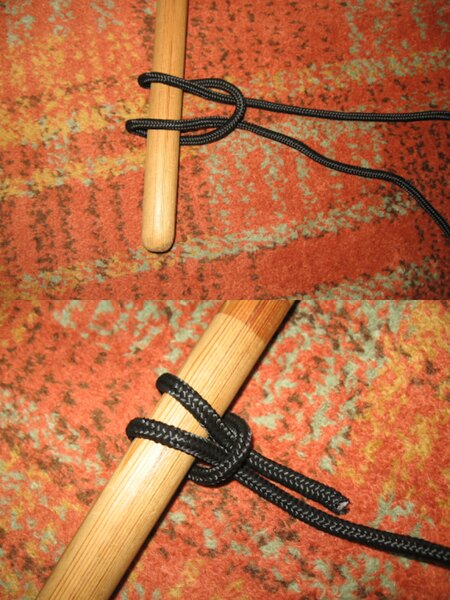
Prusik knot—a friction hitch used in climbing, rescue, and belaying. It tightens under load but slides freely along the rope when not under tension.
?? Bowline Knot
The bowline is a traditional knot used to create a fixed loop at the end of a rope. Historically, it was widely employed for tying in climbers, but today it is considered outdated and unsuitable for securing people.
The reason is its tendency to loosen under one-sided load, particularly when used with stiff or slippery ropes. In modern practice, the bowline is better suited for auxiliary attachments, securing objects, or as a temporary solution in situations where there is no direct safety risk.
?? Bowline Knot
Purpose:
Creating a fixed loop in a rope, auxiliary attachment of objects
? Advantages:
• Quick to tie
• Simple knot
• Holds its shape even without load
?? Disadvantages:
• Risk of loosening under one-sided load
• Reduces rope strength by up to 50%
• Unsuitable for securing people
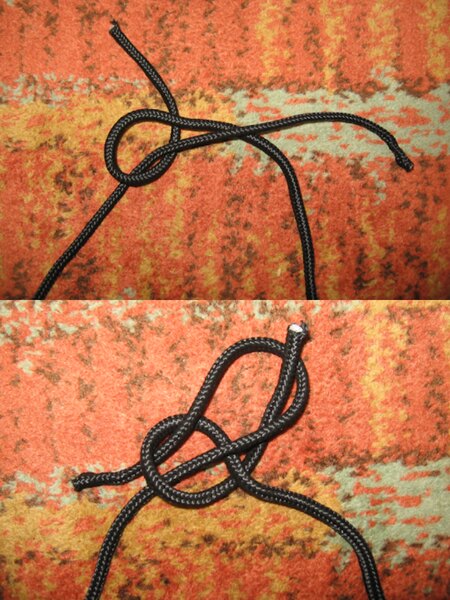
Bowline knot—a simple knot for quickly tying into a rope. It can fail under improper loading, so today it is used only in limited situations.
?? Clove Hitch
The clove hitch is a versatile knot designed for securing a rope to a solid, cylindrical object. Traditionally used for mooring boats, it is now also common in climbing, shelter construction, and material handling.
It is valued for its simplicity and the ability to be tied with one hand. It holds well on both smooth and rough surfaces, but only under even load. Under one-sided tension, it can loosen, which is why adding a backup knot is recommended.
?? Clove Hitch
Purpose:
Securing a rope to a round object (post, pole, stake), sailing, work applications, climbing
? Advantages:
• Quick to tie, even with one hand
• Adjustable length without untying
• Holds on both smooth and rough surfaces
?? Disadvantages:
• Unreliable under one-sided load
• Requires even tension
• A backup knot is recommended
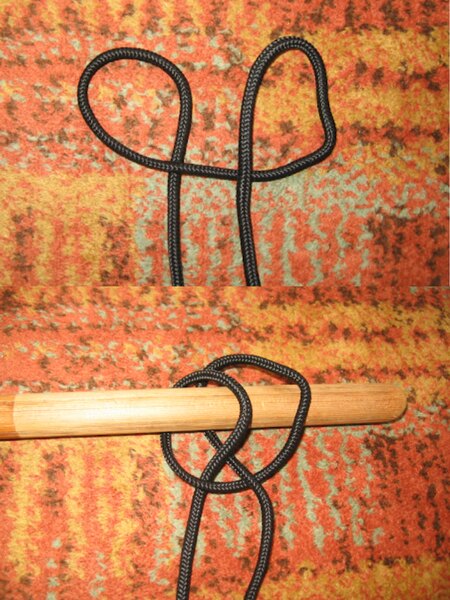
Clove hitch—a reliable knot for fastening to posts or rings. It can be tied with one hand, holds securely, and is easy to untie.
?? Figure-Eight Knot
The figure-eight knot is used to secure the free end of a rope, preventing it from slipping through a pulley, carabiner, or other anchor points. It is also used as a stopper knot when joining ropes or to prevent unraveling.
It is a simple, easy-to-recognize, and reliable knot that tightens well under load without collapsing. Its main drawback is that, after being heavily loaded, it can be very difficult to untie. The figure-eight knot is not the same as the figure-eight loop, though the two are often confused by climbers.
?? Figure-Eight Knot
Purpose:
Securing the end of a rope against slipping, terminal or safety knot
? Advantages:
• Simple and quick to tie
• Holds firmly even under load
• Easily readable knot structure
?? Disadvantages:
• Difficult to untie after load
• Not suitable for joining ropes

Figure-eight knot—a basic stopper knot used to prevent a rope from slipping out. Simple, easy to recognize, and holds securely even under load.
?? Figure-Eight Loop
The figure-eight loop is a strong and reliable knot used for tying a person into a rope—most commonly in climbing, caving, and high-access work. In modern practice, it has completely replaced the previously used bowline for this purpose.
This knot holds securely even under repeated loading and retains about 55–60% of the rope’s strength. It is important to tie it correctly and finish it with a backup knot. After a sudden heavy load, it can be difficult to untie.
?? Figure-Eight Loop
Purpose:
Tying a person into a rope – climbing, caving, high-access work
? Advantages:
• High strength and reliability
• Holds securely even under repeated loading
• Easy to tie and visually inspect
?? Disadvantages:
• Difficult to untie after heavy loading
• Requires a backup knot
• Can fail if tied incorrectly
?? Joining Ropes and Materials
This group of knots is used to connect two ropes, cords, or lines - whether they are of the same or different diameters. Emphasis is placed on the strength of the connection, the simplicity of tying, and reliability under load.
?? Fisherman’s Knot
The fisherman’s knot is a simple and strong knot designed for joining two thin ropes, cords, or fishing lines—ideally of the same diameter. It consists of two opposing overhand knots that tighten against each other when pulled.
While primarily used in fishing, it also serves in climbing as a secure connection when tying prusik loops. The knot is strong but can be difficult to untie, and if tied incorrectly, it may lose strength.
?? Fisherman’s Knot
Purpose:
Joining two thin ropes, fishing lines, or loops (e.g., prusik loops)
? Advantages:
• Very strong connection
• Works on wet or slippery materials
• Simple structure made from two basic knots
?? Disadvantages:
• Difficult to untie after loading
• Unsuitable for ropes of different diameters
• Requires careful tightening of both knots
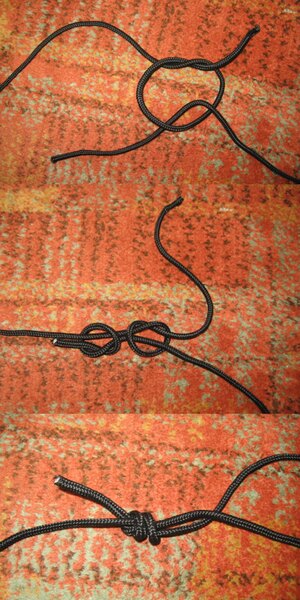
Fisherman’s knot – a simple and reliable knot for joining two thin cords or fishing lines. Best suited for materials of the same diameter.
?? Sheet Bend
The sheet bend is a versatile knot for joining two ropes or cords, even when they differ in diameter or material. It is commonly used in sailing (for example, to secure a sheet to a sail—hence the name), as well as in shelter building, scouting, and general outdoor activities.
This knot tightens securely under load, maintains good strength, and can be relatively easy to untie, even after being stressed.
?? Sheet Bend
Purpose:
Joining two ropes or cords of different diameters or materials
? Advantages:
• Works well with ropes of unequal size
• Easy to tie and untie
• Does not damage or deform the rope
?? Disadvantages:
• Can loosen if not properly tightened
• Less strong than some other joining knots
?? Timber Hitch
The timber hitch is a simple and quick knot for securing a rope to a load that needs to be dragged or carried—typically logs, beams, or other cylindrical objects. It works by tightening the loop around the object when one end of the rope is pulled.
This knot is suitable for short-term use but is not intended for lifting or lowering loads—as it may loosen under uneven tension. For greater security, a clove hitch with a backup knot can be used as an alternative.
?? Timber Hitch
Purpose:
Securing a rope to a load for dragging (e.g., logs, beams, materials)
? Advantages:
• Quick and easy to tie
• Holds well under a steady pull in one direction
• Ideal for working with wood or in the field
?? Disadvantages:
• Not suitable for lifting or lowering loads
• Can loosen if the pulling direction changes
• Requires a backup knot for added security
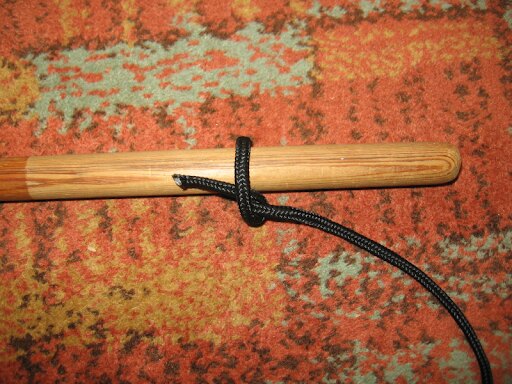
Timber hitch – a quick knot for fastening loads to a log, pole, or beam. Holds under steady pull but is not suitable for lifting or lowering.
?? Cow Hitch
The cow hitch is a simple knot for fastening a rope to a fixed object – typically one with a cylindrical shape. It is often used for hanging, securing, or temporary fastening, for example with a hammock, backpack, or shelter.
In its basic form, it serves as a binding knot. When tied with additional turns, it can also function as an emergency hitch with partial friction. For safe use, the rope’s two ends must be evenly loaded.
?? Cow Hitch (Lark’s Head)
Purpose:
Attaching a rope to a fixed object, hanging gear, binding/backup hitch
? Advantages:
• Simple and quick to tie
• Holds even on smooth surfaces
• Can serve as an emergency friction hitch with extra wraps
?? Disadvantages:
• Requires even loading on both ends
• May slip under one-sided pull
• Not suitable for dynamic loading
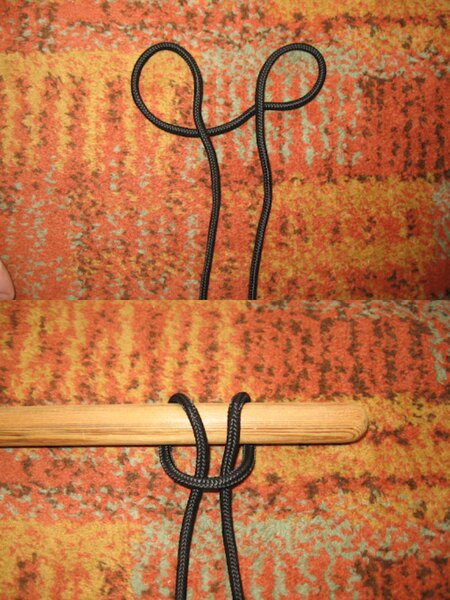
Cow hitch – a simple, quick knot for hanging an object from a pole or ring. Suitable for light anchoring, securing a hammock, and even decorative purposes.
Utility and Everyday Knots
This group of knots is designed for everyday tasks—tying parcels, building shelters, making small repairs, or working in the garden. They stand out for their simplicity, quick tying, and sufficient functionality in less demanding conditions.
?? Square Knot (Reef Knot)
The square knot is used to join two ropes or cords of the same diameter, primarily in simple, utility situations. It’s suitable for tying bandages, securing parcels, or bundling items together.
It is not intended for load-bearing or critical connections, as it has a tendency to slip—especially on synthetic materials. When pulled tight, it can damage the rope, so it’s better suited for soft materials or temporary bindings.
?? Square Knot (Reef Knot)
Purpose:
Joining two ropes or cords of the same diameter, such as when tying bandages, parcels, or bundles.
? Advantages:
• Simple and quick to tie
• Lies flat – suitable for medical use
• Easy to untie (with a slip loop)
?? Disadvantages:
• Slips on synthetic materials
• Not suitable for ropes of different diameters
• Can damage the rope when pulled tight
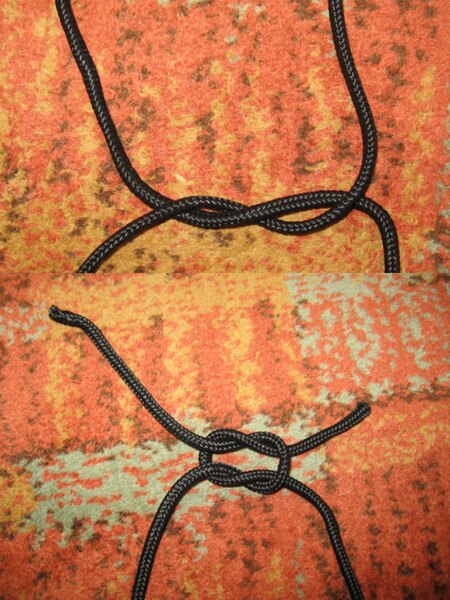
Square knot – a basic joining knot ideal for tying bandages, scarves, or bundles. Easy to tie, but not intended for high-load applications.
?? Cross Lash
The cross lash is a simple knot used to attach one rope to another, typically at a right angle. It is suitable for light structures, supports, or fastening a rope to intersecting elements.
It is not designed for load-bearing purposes—under significant tension, it can easily slip, especially when joining ropes of different diameters or materials. In practice, it is mainly used in camping or temporary constructions, such as securing a rope to a post or railing.
?? Cross Lash
Purpose:
Attaching a rope to a crossing element (e.g., a post), light structures
? Advantages:
• Extremely simple to tie
• Quick to use for non-critical lashings
• Effective when firmly seated against a support
?? Disadvantages:
• Low strength
• Slips under uneven load
• Not suitable for joining ropes
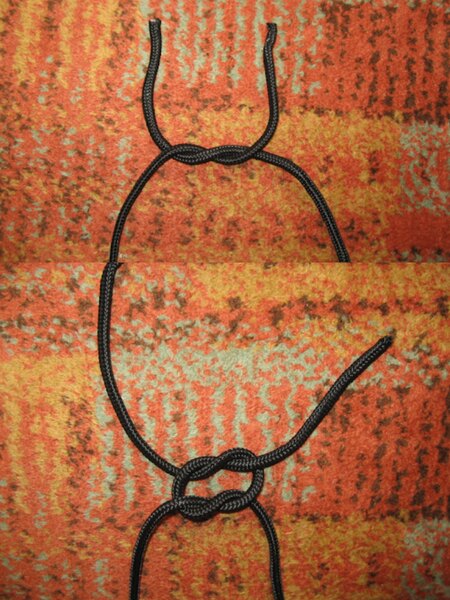
Cross lash – a basic knot for securing two ropes at a right angle. Suitable for light structures and situations where high strength is not required.
?? Shortening Knot
The shortening knot allows you to temporarily shorten an overly long rope without cutting it. It is useful, for example, when building shelters or securing a tarp, where rope length needs to be adapted to different conditions.
This knot is suitable only for soft, flexible ropes. It is not designed for load-bearing and should be used solely as a temporary solution. Both ends must be secured to prevent it from loosening.
?? Shortening Knot
Purpose:
Temporary rope shortening without cutting (e.g., when securing a shelter)
? Advantages:
• Allows rope length adjustment
• Easy to tie
• Does not damage the rope
?? Disadvantages:
• Suitable only for soft ropes
• Not intended for load-bearing
• Both ends must be secured to prevent movement
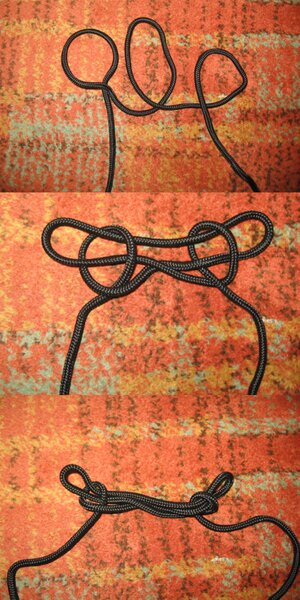
Shortening knot – a practical solution for adjusting rope length without permanent alteration. Ideal for temporary field use. Ends must be secured!
?? Josephine Knot
The Josephine knot, also known as the friendship knot or Carrick bend, is used to join two ropes of equal diameter in non-demanding situations. It is commonly applied for tying bandages, scarves, or bundles, particularly in first aid or camping scenarios.
Despite its decorative appearance, it is not suitable for load-bearing — it can loosen easily if both ends are not evenly tensioned. When tied with slippery or unevenly sized materials, it may slip.
Historically, the knot has been known since Viking times and even appears in heraldry, such as in the emblem of the RAF’s No. 2 Squadron.
?? Josephine Knot
Purpose:
Joining two ropes of equal diameter in practical or symbolic applications
? Advantages:
• Easy to tie and visually clear
• Attractive decorative appearance
• Useful in first aid or scouting
?? Disadvantages:
• Low strength
• Easily loosens under one-sided load
• Unsuitable for slippery or uneven materials
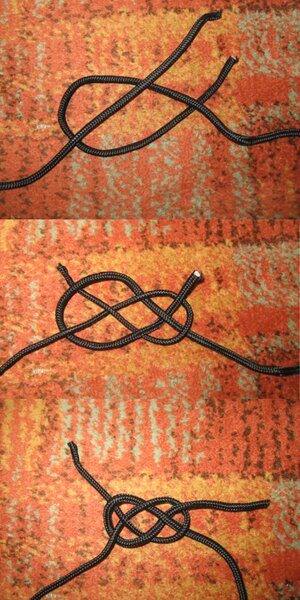
Josephine Knot – an aesthetically pleasing, symmetrical, and simple knot for joining ropes of equal diameter. Suitable for decorative purposes, first aid, or scouting activities – but not recommended for heavy loads.
?? Fixed Loop (Eye Loop)
A fixed eye loop is a simple knot for quickly creating a loop at the end of a rope. It is commonly used for anchoring tent lines, tying down equipment, or securing loads in light-duty situations. It is not suitable for personal safety or heavy loads, as it may come undone under tension.
For increased safety, always secure the free end of the rope with an additional stopper knot.
?? Fixed Loop (Eye Loop)
Purpose:
Creating a loop for light anchoring, shelter building, or tying items
? Advantages:
• Quick and easy to tie
• Useful in common outdoor situations
• Flexible and easily adjustable
?? Disadvantages:
• Not suitable for securing people
• May come undone under load
• Requires additional securing of the free end

Fixed Loop (Eye Loop) – a straightforward knot for quickly forming a loop in a rope. Suitable for anchoring, shelter building, or securing gear. For added safety, the free end should always be secured.
?? Special Techniques and Paracord
Knots and ties in this category are not intended for securing loads or rescue operations. Instead, they are used in survival skills, crafting improvised equipment, and creating practical or decorative accessories from paracord. This includes both functional knots and ornamental ties. Here, we’ll keep things brief – the goal is to give a quick overview of the possibilities.
?? Monkey’s Fist
The Monkey’s Fist is a decorative knot that forms a weighted, spherical end—often with a ball or other weight inserted inside. In maritime use, it serves to add weight to a rope’s end, making it easier to throw over long distances. In survival contexts, it can function as an improvised weight and, in some cases, as a defensive tool (sometimes referred to as a “paracord mace”).
?? Monkey’s Fist
• Use: maritime, survival, decoration
• Function: weighted end on a rope; both a stylish and practical element
?? Survival Paracord Bracelet
A survival paracord bracelet serves as a backup cord for emergency use in the field. Inside, it contains several meters of paracord that can be quickly unraveled and deployed in a crisis. The bracelet also functions as a practical accessory and an integral part of tactical gear.
?? Survival Paracord Bracelet
• Uses: backup cord, outdoor gear
• Function: a stylish bracelet with practical potential
?? Paracord Keychains and Lanyards
Paracord keychains and lanyards are used to secure gear—such as knives, flashlights, or pendants—to a backpack, belt loop, or belt. In addition to their practical use, they also provide a length of spare cord that can be deployed in an emergency. There are numerous knotting and weaving techniques that allow you to craft these accessories at home.
?? Paracord Keychains and Lanyards
• Usage: attaching equipment, emergency cord
• Function: stylish and functional accessory for backpack, gear, or belt
Knots Overview: When to Use Them, What They Can Do, and When to Avoid Them
The table below provides a quick reference to all the knots mentioned in this article—including their primary uses, strengths, and weaknesses. It will help you choose the right knot for a given situation while also highlighting the potential pitfalls to watch out for.
| Knot Name | Primary Use | Advantages | Disadvantages |
|---|---|---|---|
| Prusik Knot | Climbing, rescue, ascending | Self-locking, simple, reusable | Not for dynamic loads, slips on wet rope |
| Bowline | Tying into a rope, rescue | Quick to tie, used in climbing | Reduces rope strength, may slip |
| Clove Hitch | Fastening rope to a post or ring | Easy to tie and untie quickly | May loosen with changing load |
| Figure Eight Knot | Securing rope ends | Simple, holds well, easy to inspect | Hard to untie after heavy load |
| Figure Eight Loop | Tying in climbers, securing people | Safe, standard in climbing | Requires correct tying and backup knot |
| Fisherman’s Knot | Joining thin cords or fishing lines | Very strong connection | Difficult to untie after load |
| Sheet Bend | Joining ropes of different diameters | Easy to tie, holds well | May loosen without tension |
| Timber Hitch | Anchoring, hauling logs | Holds even on slippery surfaces | Can tighten excessively |
| Cow Hitch | Hanging items via a loop | Can be tied one-handed | May jam under load |
| Square Knot | Binding, first aid | Simple, quick to tie | Low strength, slips under strain |
| Cross Knot | Joining ropes at right angles (e.g., temporary structures) | Holds shape, stable connection | Less known, not for heavy loads |
| Sheepshank | Shortening rope without cutting | Quick, reversible shortening | Not load-bearing, temporary only |
| Carrick Bend | Joining two ropes of equal size | Easy, symmetrical | Loosens easily, not load-bearing |
| Fixed Loop | Creating a quick loop on a rope | Easy to untie after load | Needs backup, can untie under load |
In Conclusion: Knots Worth Knowing by Heart
Knowing a handful of basic knots can come in handy far more often than you might expect—not only when building a shelter or replacing a strap on your backpack, but also in critical situations where time and reliability matter. The more knots you master, the more options you have—whether you’re traveling, working in the field, or enjoying outdoor adventures. Practice makes perfect—and a well-tied knot never gets in the way.
Readers are further interested
